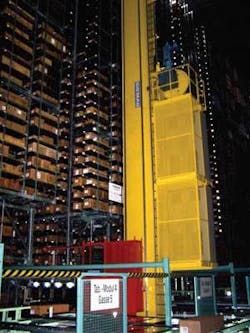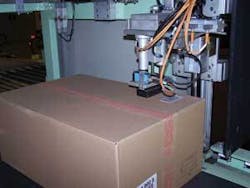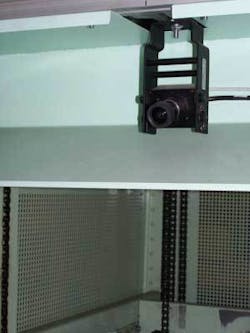Vision speeds barcode reading
A warehouse package-tracking and management system relies on off-the-shelf OCR software.
By Ralf Grieser and Lutz Kreutzer
Quelle provides Germany with consumer goods from its mail-order catalog and Web site. To speed the delivery of incoming goods at its distribution facility, Quelle uses several conveyor-belt systems to transport the items into a warehouse, where they are stored in racks. Close to this warehouse are other buildings where the goods are repacked before being shipped to customers.
Every item must be registered and transported by the conveyors to racks that are used to house more than 2 million packages as a buffer pool. If packages are not registered properly, they may become lost inside the warehouse. Because of this, every package must be reliably marked by a label specified by Quelle. This label must not exceed 135 × 90 mm and must display a seven-digit product number, a four-digit quantity description, and a six-digit vendor number in Helvetica or Arial printed in black with a minimum font size of 12 mm. An EAN 128 barcode stores these parameters.
After packages are delivered, each is measured, weighed, and given another internal barcode label called a KID (Karton Identification Number), which is attached to the package during processing (see Fig. 1). All specific parameters and the relative whereabouts of a package-registered by different barcode scanners during its transportation-are linked to the KID by a Siemens S5 SPC. Because of the large number of packages delivered, it is impossible to perform these tasks manually. And, while most vendors adhere to the label guidelines, some packages do not have any labels, use the incorrect font, or are labeled by hand. Other labels are squashed, crumpled, or difficult to read. This leads to difficulties during barcode and OCR reading, making package identification by machine vision impossible.
After providing each package with a KID barcode, the vendor’s EAN 128 code is read by a barcode reader located above the conveyor belt. In operation, 75% of all packages can be read in this manner. A machine-vision system increases the identification rate of the 25% unreadable labels. Normally, one-dimensional barcodes such as the KID can be read without problems. However, sophisticated OCR needs complex machine-vision technologies.
To configure the machine-vision system, an i-Cam 108 camera from Baumer Optronics was used with Baumer’s OCR software to find and read package labels (see Fig. 2). After a label is located, a region of interest (ROI) inside the label is searched for fonts or codes. If the result from the barcode reading of the EAN 128 vendor label and the result of the OCR are identical, the task is complete and the package is classified as identified.
However, although the combination of i-Cam hardware and software was effective, system reliability was still too low. If barcode reading or OCR does not deliver a result, an additional step is required. If the OCR and barcode do not produce identical results, the ROI of the image is sent to a PC where another proprietary OCR program runs in parallel with HALCON machine-vision OCR software from MVTec Software.
Results from both OCR software threads running on the PC are compared with the OCR result of the i-Cam. If at least two results of the three OCR measurements match, the job is complete. If not, the package is rerouted to another conveyor where operators manually read the label and apply the correct barcodes.
Ten years ago, at the Quelle Logistic Center, every package was registered by this Video Codierung (video encoding system) without barcode reading or machine-vision applications. According to Kerstin Mehlhose, plant engineer at Quelle, using the i-Cam OCR with HALCON OCR software on the PC has increased the degree of automation by 18%.
Finally, the package is shifted onto a metal tray that has its own barcode at its underside-the Tablar (or tray) Identification Number (TID). This TID is linked to the KID before the tray leaves the belt to be stacked. From this point, only the TID is used to find packages with a warehouse-management system from Siemens. Instructed by the warehouse-management system, a giant rail-bound lift vehicle carries the trays into the racks where they are stored (see photo on p. 15). The warehouse-management system also removes the tray with the requested packages when the goods need to be shipped, a process that is dictated by customer orders placed by mail order, telephone, or over the Internet.
Ralf Grieser is product manager, Baumer Optronic (Radeberg, Germany; www.baumeroptronic.de), and Lutz Kreutzer is manager of public relations and marketing, MVTec Software (Munich, Germany; www.mvtec.com).
Company Info
Baumer Optronics
Radeberg, Germany
www.baumeroptronic.de
MVTec Software
Munich, Germany
www.mvtec.com
Quelle
Leipzig, Germany
www.quelle.de



